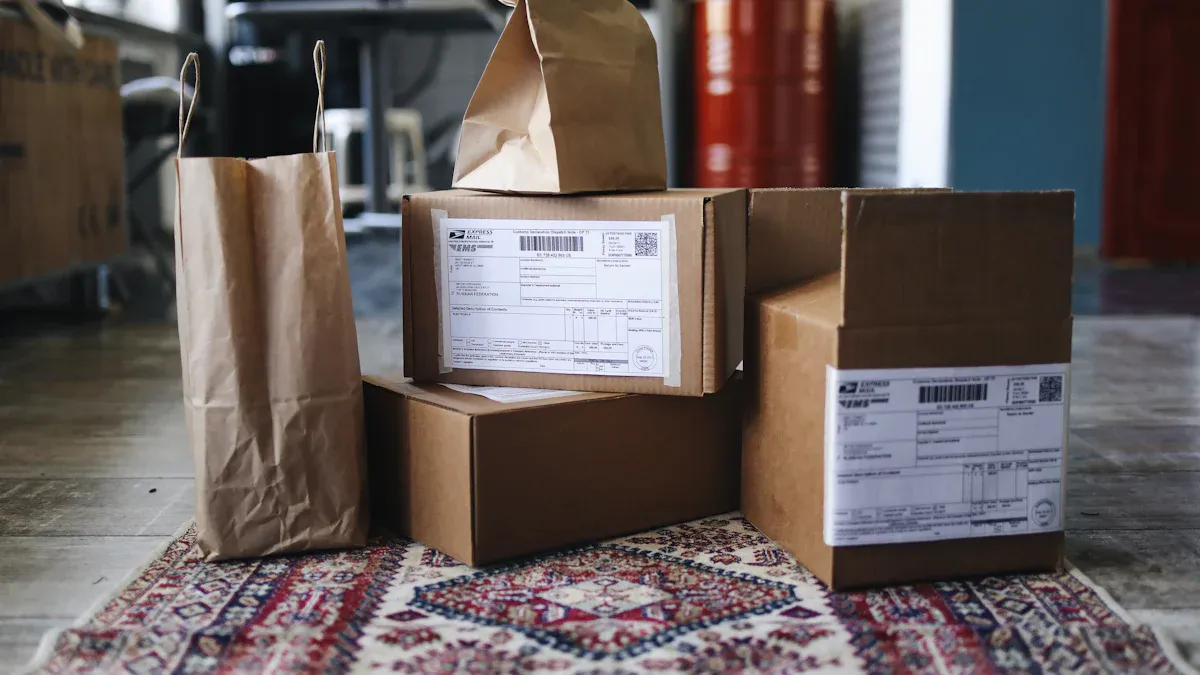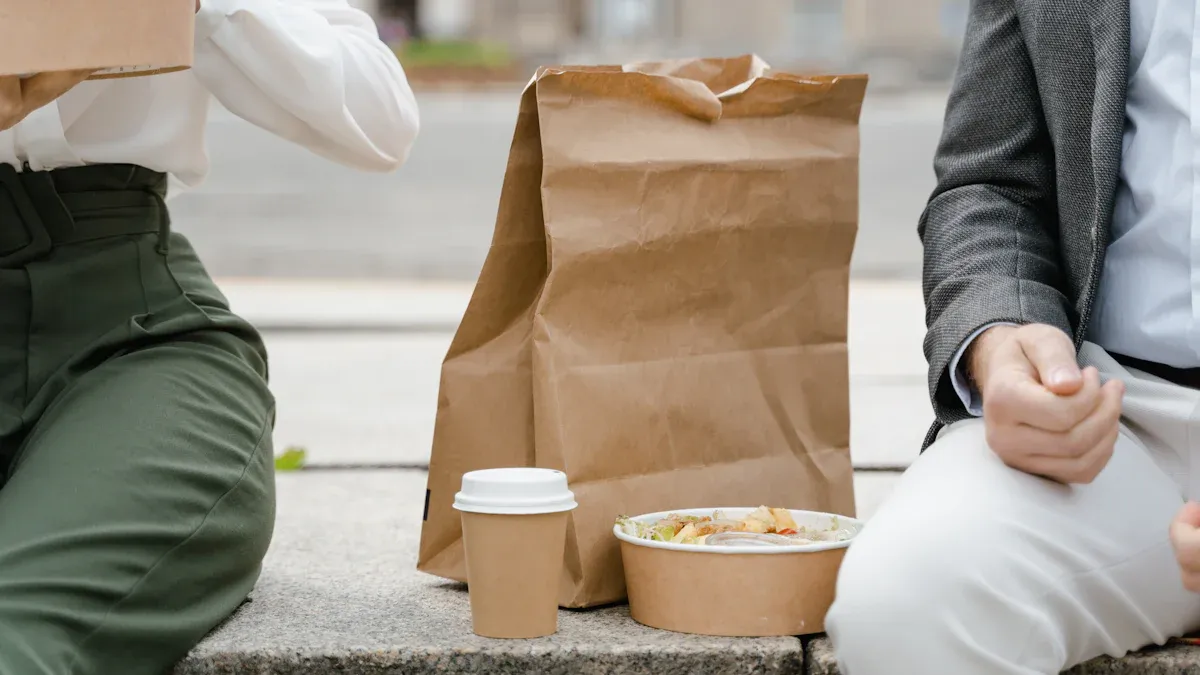
Super Hi-bulk uncoated food grade packaging paper roll material base paper offers safety, strength, and sustainability for food packaging. Businesses often select it for these reasons:
- Safe for direct food contact and free from harmful chemicals.
- Made from Roll Raw Material Virgin For Paper, ensuring durability.
- Supports clear branding, unlike Normal Food-Grade Board or Folding Box Board For Food.
Super Hi-bulk Uncoated Food Grade Packaging Paper Roll Material Base Paper: Safety, Sustainability, and Performance

Food Safety and Compliance
Regulatory agencies such as the FDA and EFSA set strict standards for food packaging materials. They focus on the composition of the material, ensuring it does not contain harmful chemicals that could migrate into food. Super Hi-bulk uncoated food grade packaging paper roll material base paper meets these requirements by using pure cellulose fibers and avoiding toxic additives. Agencies also test for chemical migration under heating and microwave conditions. Studies show that plain, uncoated food-grade paper maintains its structure up to 150°C and exhibits negligible chemical migration, making it safe for direct food contact.
Microbiological safety is another priority. The paper’s manufacturing process prevents microbial growth, ensuring food remains uncontaminated. Regulatory guidelines require clear labeling and usage instructions, which help consumers use the packaging safely. Ongoing research and innovation in material science continue to improve the safety profile of this packaging material.
Note: Super Hi-bulk uncoated food grade packaging paper roll material base paper is certified QS compliant, meeting national food safety standards for direct contact with food.
Environmental Impact and Resource Conservation
Sustainability is a key advantage of this packaging material. Manufacturers use 100% virgin wood pulp, a renewable resource, to produce the base paper. This approach reduces reliance on non-renewable materials and supports responsible forestry practices. The paper is lightweight and uncoated, which means it does not require plastic or polymer coatings that can harm the environment.
The biodegradability of super hi-bulk uncoated food grade packaging paper roll material base paper stands out when compared to other packaging materials. The following table highlights how it compares to common alternatives:
| Material Type | Biodegradability Rate / Notes | Barrier Properties / Additional Info |
|---|---|---|
| Super hi-bulk uncoated food grade paper | Inherently high biodegradability due to cellulose base; exact rate not quantified but superior to petroleum-based plastics | Poor barrier properties due to porous structure; not typically used alone without coatings |
| Polybutylene succinate (PBS) | High biodegradability: 13 mg/cm² weight loss per month | Good oxygen/water vapor barrier similar to PLA; semi-crystallized PBS has oxygen barrier ~200-300 cc mil/m²-day-atm |
| Polycaprolactone (PCL) | Biodegradable synthetic polyester; rate not quantified here | Poor oxygen and water vapor permeability; often blended to improve barrier properties |
| Starch | Naturally biodegradable; low cost; rate not quantified here | Brittle films unless modified; can improve moisture and oil barrier when blended/coated |
| Cellulose (base of paper) | Most abundant natural biodegradable polymer; inherently high biodegradability | Hydrophilic, poor film-forming alone; derivatives used to improve barrier properties |
| Petroleum-based plastics (PE, PS, PET) | Non-biodegradable | Good barrier properties but environmentally harmful; synthetic coatings reduce paper biodegradability |
Paper packaging offers more sustainable end-of-life options than plastic or aluminum. It can be recycled up to six or seven times, composted, or incinerated for energy recovery. These options reduce landfill waste and toxic emissions. In contrast, plastic packaging is often non-biodegradable and difficult to recycle, while aluminum requires significant energy for recycling.
Recent innovations have further improved sustainability. Manufacturers now produce super hi-bulk uncoated Bristol board from 100% raw wood pulp, making it both food-safe and ecological. The paper provides natural insulation and supports various printing methods, allowing it to replace plastics in many applications. Its lightweight nature reduces shipping emissions and costs, supporting global green packaging trends.
Strength, Bulk, and Product Protection
Super Hi-bulk uncoated food grade packaging paper roll material base paper delivers excellent protection for food products during shipping and handling. Its increased thickness and stiffness provide enhanced durability and rigidity. This bulk acts as a cushion, reducing the risk of damage to fragile or delicate items.
- The natural, textured surface adds a premium feel and ensures product safety.
- Lightweight construction helps lower shipping costs without sacrificing strength.
- Tear resistance and durability allow the packaging to withstand the stresses of transportation and handling.
- The paper’s uniform thickness and folding resistance maintain package integrity, even for heavy or oddly shaped items.
These features make high bulk paper ideal for robust protection of food-grade products. Businesses benefit from reduced product loss and improved customer satisfaction.
Super Hi-bulk Uncoated Food Grade Packaging Paper Roll Material Base Paper: Printability, Cost, and Comparison
Printability and Branding Potential
Super Hi-bulk uncoated food grade packaging paper roll material base paper supports a wide range of printing methods. Businesses often use offset, screen, digital, flexography, and gravure printing. Food-safe inks, such as soy and water-based inks, help maintain safety and sustainability. The uncoated surface absorbs ink, resulting in softer and more muted images. This creates a natural, tactile look that appeals to many brands.
Surface texture also plays a key role in branding. Vellum finishes offer a slightly textured, elegant appearance. Laid finishes provide a traditional, premium feel. Wove finishes deliver a clean, professional look. These textures enhance the tactile experience and help brands stand out on the shelf. The natural, uncoated texture aligns with eco-friendly branding, attracting environmentally conscious consumers.
Cost-Effectiveness and Economic Value
Super Hi-bulk uncoated food grade packaging paper roll material base paper offers strong economic value. Paper grades such as corrugated and mixed paper range from $56 to $138 per ton. In comparison, plastic packaging materials like PET and HDPE cost $245 and $588 per ton, respectively. Coated papers and biodegradable coatings are even more expensive. The lower cost of uncoated paper helps businesses manage expenses while meeting food safety and sustainability goals.
Comparison with Alternative Packaging Materials
Consumers increasingly prefer sustainable packaging. Businesses respond by choosing food-safe, eco-friendly paper solutions. Super Hi-bulk uncoated food grade packaging paper roll material base paper meets these demands. It provides biodegradability, food safety, and a natural look. Unlike plastic, it does not harm the environment. Unlike coated papers, it offers a tactile, authentic feel. This material helps brands align with consumer values and market trends.
Many businesses choose this packaging paper for its safety, sustainability, and cost savings. Companies use it for cups, soup cups, and take-away food boxes. The material works well for hot and cold drink cups. It protects food, supports branding, and meets strict food-grade standards.
FAQ
What makes super hi-bulk uncoated food grade packaging paper safe for food contact?
Manufacturers use pure cellulose fibers and avoid harmful chemicals. This ensures the paper meets strict food safety standards for direct contact with food.
Can this packaging paper be recycled or composted?
Yes!
- The paper is fully recyclable and compostable.
- It breaks down naturally, supporting eco-friendly waste management.
What types of food packaging use this material?
Super hi-bulk uncoated food grade paper works for cups, bowls, napkins, and take-away boxes. Many food businesses choose it for both hot and cold food items.
Post time: Aug-04-2025
